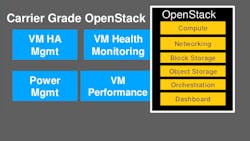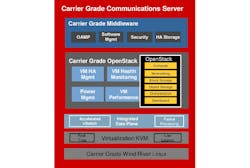Packaged Linux Delivers Network Functions Virtualization
Network Functions Virtualization (NFV) and Software Defined Networking (SDN) are all the rage as conventional computing platforms have taken up the challenge of network routing and management (see “What's The Difference Between SDN and NFV”). The trend is to integrate monolithic, vertically integrated hardware like gateways and routers into a single, virtualized, hardware platform.
Related Articles
- What's The Difference Between SDN and NFV
- High-Availability Carrier-Grade Linux Does DRDB
- Carrier Grade Linux Delivers Bare-Metal Virtualization
Platforms such as OpenStack are making that job easier. Integrating and deploying OpenStack is not a trivial task and it is only part of a complete system that is used to deliver network services.
Wind River's Carrier Grade Linux Communication Server (Fig. 1) is designed to provide OpenStack support out of the box. It is based on Wind River's Carrier Grade Linux with KVM virtualization support that is designed to work with their Data Plane Development Kit (DPDK). The user space Open vSwitch support works with 10G Intel ARK/Niantic Ethernet adapters as well as Mellanox Ethernet/InfiniBand adapters.
The server can be installed from a flash drive or other storage device. The system is complete and designed to deliver 99.999% availability with minimal loss of server and data on failover. It supports live patching and hitless upgrades. The system is designed for very large applications on the order of 100,000+ customers with carrier grade SLAs (service level agreements).
The architecture supports different installations with the default being two payload and two controller servers. The controllers start up with the OpenStack dashboard. The systems are designed for redundancy and scalability. It allows developers to build on top of a very complete and robust system.
The Carrier Grade Linux Communication Server targets COTS hardware. Developers will still be able to customize the system and add their own software on top but Wind River provides that basis for a complete system. This includes services such as packet acceleration, content inspection and flow analysis.
About the Author
William G. Wong
Senior Content Director - Electronic Design and Microwaves & RF
I am Editor of Electronic Design focusing on embedded, software, and systems. As Senior Content Director, I also manage Microwaves & RF and I work with a great team of editors to provide engineers, programmers, developers and technical managers with interesting and useful articles and videos on a regular basis. Check out our free newsletters to see the latest content.
You can send press releases for new products for possible coverage on the website. I am also interested in receiving contributed articles for publishing on our website. Use our template and send to me along with a signed release form.
Check out my blog, AltEmbedded on Electronic Design, as well as his latest articles on this site that are listed below.
You can visit my social media via these links:
- AltEmbedded on Electronic Design
- Bill Wong on Facebook
- @AltEmbedded on Twitter
- Bill Wong on LinkedIn
I earned a Bachelor of Electrical Engineering at the Georgia Institute of Technology and a Masters in Computer Science from Rutgers University. I still do a bit of programming using everything from C and C++ to Rust and Ada/SPARK. I do a bit of PHP programming for Drupal websites. I have posted a few Drupal modules.
I still get a hand on software and electronic hardware. Some of this can be found on our Kit Close-Up video series. You can also see me on many of our TechXchange Talk videos. I am interested in a range of projects from robotics to artificial intelligence.


